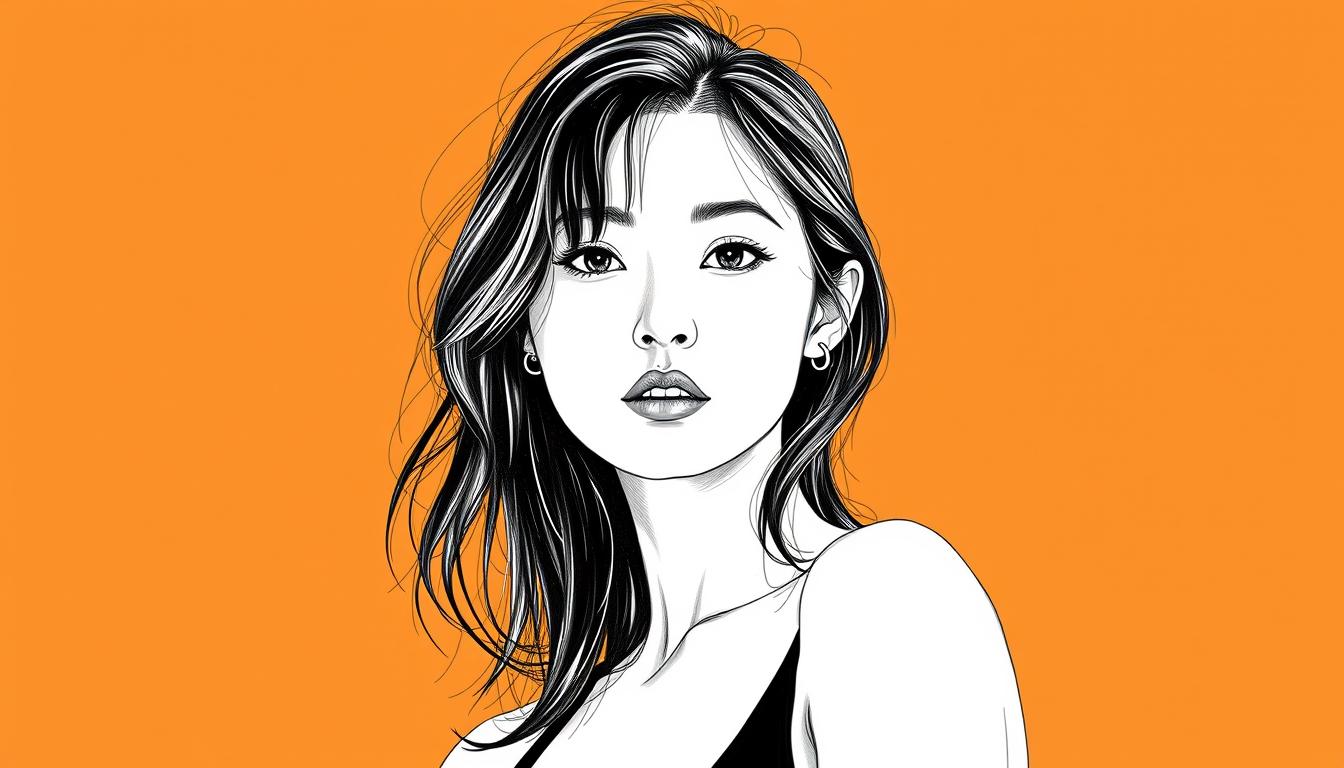From Sagamihara, Kanagawa, she emerged with the height and presence for international runways. At 5’10½”, she possessed the physical attributes the fashion world demands.
Her singular look set her apart. It was androgynous, striking, and unmistakably her own. This distinction proved vital in a crowded field.
Born in 1982, she entered modeling during her adolescence. At that time, Asian representation on European catwalks remained scarce. She became a pioneering Japanese model, commanding attention where few had gone before.
Her career is built on determination and craft, not celebrity noise. Represented by IMG Models, she maintains a base in Tokyo. This choice reflects a deliberate connection to her roots while sustaining a global presence.
Introduction: The Rise of a Japanese Model Icon
The appointment as Paris Fashion Week’s ambassador in Japan marked a milestone for Asian representation. This recognition from Western fashion circles honors decades of consistent work, not fleeting fame among celebrities.
She entered the modeling world at fifteen, learning the industry’s rhythms before most finish school. Her career spanned major shifts in taste, technology, and global representation.
The title “supermodel” demands more than temporary buzz. It’s built on campaign volume, show caliber, and lasting brand relationships. True icons maintain their position in the fashion frontline through steady accumulation of respected work.
Her distinctive androgynous look and ideal physique made her an iconic Asian figure in modeling. She appeared in international editions of Vogue, Harper’s Bazaar, and ELLE when such visibility was rare for Asian celebrities.
This interview profile examines her journey from Tokyo runways to the international stage. It explores the craft and resilience that defined a career built on professionalism, not instant fame.
Early Beginnings in the Fashion Industry
The local Tokyo fashion circuit became her training ground. She learned the unspoken rules of the catwalk before dreaming of international stages.
Debut on Local Runways
At fifteen years old, she recognized her height was right for modeling. Tokyo Fashion Week provided her first real runway experience. She spent those early years mastering timing and posture.
The relentless pace of shows and castings defined her adolescence. Fitting rooms and backstage chaos replaced typical teenage pursuits. She absorbed the craft that would later carry her across continents.
First Steps into International Fashion
The transition demanded more than just height and look. It required resilience and adaptability. Few Asian models reached European and American runways at that time.
These formative years built the foundation for everything that followed. Success in fashion isn’t about luck alone. It’s about showing up, learning fast, and earning your place one show at a time.
Breakthrough Moments on International Runways
At seventeen, a runway in New York City transformed a career. The local circuit was a memory. The global stage called.
New York Fashion Week Debut
Walking for Luca Luca at New York Fashion Week marked the true beginning. The difference in scale was immediate. Dozens of cameras flashed at the end of the runway, a level of attention reserved for top celebrities.
She felt goosebumps from the excitement. It was a visceral confirmation. This work felt like destiny, not just a job.
That debut on the New York fashion scene opened doors for Asian models. It proved she belonged among established models on the international stage. The moment was about craft and confidence, not fame.
New York became her proving ground. She returned each season, building relationships with designers who valued her unique presence. This breakthrough was just the start of a decades-long journey.
Editorial Triumphs and Magazine Covers
Beyond the runway, her editorial work cemented her status. A model’s face on a magazine cover carries a different weight. It signifies editorial trust and market appeal.
Ai Tominaga’s portfolio of covers is vast. She graced the cover of Vogue in her home country. Her presence on Harper’s Bazaar was particularly significant.
Her Harper’s Bazaar covers demonstrated broad appeal across diverse Asian markets:
- Japan
- China
- Singapore
- Malaysia
- Indonesia
She also appeared on the cover of Elle in Japan, Singapore, and Hong Kong. Other notable covers included Marie Claire Hong Kong and Madame Figaro in Taiwan and Thailand. This range showed both regional relevance and international prestige.
Inside these fashion magazines, her work was equally commanding. She appeared in editorials for American, French, British, Japanese, Russian, and German Vogue. These features showcased her versatility.
She could embody high fashion concepts and commercial appeal with equal skill. Editors and photographers chose her repeatedly as a muse. This consistency proved her professional value beyond fleeting trends.
In an era with limited space for Asian models in Western publications, these triumphs were profound. They placed her among the top-tier professionals of her generation. Her craft, not celebrity buzz, earned every page.
Runway Highlights: Iconic Fashion Shows
The world’s most prestigious fashion houses became her second home during fashion week seasons. Her runway resume reads like a who’s who of design excellence. She walked for houses that defined contemporary fashion.
| Designer | Show Characteristics | Season Highlight |
|---|---|---|
| Christian Dior | Haute couture elegance | Paris Fashion Week |
| Alexander McQueen | Avant-garde spectacle | Theatrical presentations |
| Gucci | Luxury ready-to-wear | Milan collections |
| Dolce & Gabbana | Sicilian drama | Mediterranean inspiration |
These fashion shows demanded different energies and walks. She adapted her look for each designer’s vision. From John Galliano’s romanticism to Ralph Lauren’s American sportswear, she transformed completely.
Tominaga appeared in the 2004 Pirelli Calendar among top celebrities. This honor confirmed her status beyond typical runway work. The calendar celebrates photography as art, placing models among cultural icons.
Her consistency across these diverse runways built lasting designer relationships. Each season brought new challenges that she mastered through professional dedication. The fashion world respected her ability to embody any creative vision.
Collaborations with Prestigious Fashion Houses
Collaborating with legendary designers meant entering their creative vision completely. She shed personal identity for pure artistic expression.
Experiences with Christian Dior and Dolce & Gabbana
Working with Christian Dior taught her the precision of haute couture. Every stitch mattered. The house demanded models embody elegance, not just display clothes.
Dolce & Gabbana brought Mediterranean drama to the runway. Their shows required a different energy. She learned to channel the brand’s signature passion and flair.
These houses showed her that high fashion is about craftsmanship. The attention to detail in every garment was extraordinary. Models became living elements of the designer’s world.
Memorable Moments with Alexander McQueen
But Alexander McQueen’s A/W 2003 show remains unforgettable. Inspired by Siberian travelers, the collection was pure theater. McQueen personally chose her for the finale.
She wore a delicately embroidered kimono in a transparent tunnel. A relentless wind machine created whirlwinds around her. The heavy haori kimono felt like a futon.
“I felt transformed into some other special existence,” she recalls. “I wasn’t a human being anymore.” The experience blurred fashion and art.
This look required her hair and body to withstand the powerful wind. It became a visual spectacle that defined McQueen’s genius. That moment encapsulated his most ambitious creative ideas.
These collaborations weren’t just career highlights. They shaped her understanding of fashion as true art.
Campaign Successes and Brand Ambassadorships
The true test of a model’s versatility often happens not on the catwalk, but in the studio during a campaign shoot. This work translates a designer’s vision into an image that sells.
It demands a different skill. The camera captures nuance and commercial appeal.
Yves Saint Laurent and Gucci Campaigns
Ai Tominaga’s campaign for Yves Saint Laurent placed her among other top models like Jacquetta Wheeler and Carmen Kass. This placement was a clear signal. She belonged with the fashion world’s elite.
Her portfolio extended to Gucci, Hermès, and Tag Heuer. She also worked with Banana Republic and Moschino. This range showed an ability to move between high luxury and accessible brands.
Each campaign required embodying a distinct brand identity. For Hermès, it was timeless elegance. For Gucci, modern sophistication.
Brand ambassadorships and repeat work reflect long-term trust. They are built on professionalism, not just a single successful shoot. Her consistent presence showed she was a collaborator, not just a face.
Transition into Acting and Television
In 2003, a parallel career path opened, demanding a different set of skills entirely. The model began working as an actress, appearing in films like Devilman.
This move beyond the runway required learning a new craft. It was a shift from solitary performance to collaborative storytelling.
From Runway to Screen
Her early film work built a foundation. Roles in projects like R100 and From the End of the World demonstrated her range.
On television, her breakthrough came with Grand Maison Tokyo. She played Linda Machiko Richard, a powerful magazine editor.
This character was the ex-girlfriend of the lead, played by Takuya Kimura. Linda Machiko offered emotional depth and complex rivalry scenes.
She has called this her most memorable role. It marked her first prime-time series, a significant step for any performer.
Subsequent television roles in Waru and Ōoku: The Inner Chambers showed further versatility. An upcoming project, Unbound, continues this trajectory.
In an interview, she differentiated the two crafts with characteristic modesty. She noted modeling is a solo performance, while acting requires others to build a story.
Many celebrities attempt this transition with mixed results. Her approach reflects the same professionalism that defined her modeling career. She focuses on learning the craft and earning her place.
The Grand Maison franchise remained important. She later reprised the role of Linda Machiko in La Grande Maison Paris.
Personal Life and Motherhood Insights
The most transformative moment of her life came not on a runway but in a delivery room in 2005. She gave birth to a son, an event that fundamentally reshaped her understanding of success and purpose.
Balancing Career and Family in Tokyo
Married to a Japanese chef in 2004, she gave birth the following year. At twenty-three, she made headlines walking Kenzo’s spring 2006 runway with her infant son in her arms.
This public moment challenged industry norms. More significantly, it signaled her commitment to integrating motherhood with her career.
She describes her son’s birth as the most important moment of her life. “After becoming a mother, I felt I was no longer living merely for myself,” she reflected. “Motherhood is the greatest love.”
The model chose a three-year hiatus to spend time with her son. This decision carried professional risk in an industry where new faces appear daily.
Following her divorce in 2009, she continued balancing single motherhood with career demands from her Tokyo base. Her choices reflected deliberate priorities during her son’s formative years.
This period added depth to her public persona. It revealed the universal challenges working mothers face, regardless of industry stature.
Navigating Cultural Identity in Global Fashion
The landscape for Asian representation on global catwalks has shifted dramatically over two decades. Today’s fashion weeks regularly feature diverse faces. This was not the norm when Tominaga began her career.
Asian models were a rare sight on Western runways back then. Securing a spot felt like winning a life-changing ticket. It opened doors that had been firmly shut.
She was clear-eyed about the hurdles. The industry’s narrow beauty standards posed a constant challenge. Limited casting opportunities added to the pressure.
There was also the weight of representing an entire demographic. It was a burden she carried with professionalism. She had to balance her Japanese heritage with the expectations of the global fashion world.
Her distinctive androgynous look helped her transcend certain stereotypes. It allowed designers to see her universal appeal. Yet, it never erased the reality of scarce representation.
Her success demonstrated that Asian faces could sell clothes and grace major magazine covers. This proof helped catalyze the fashion world’s gradual move toward diversity. She paved the way for the next generation of models.
Tominaga views this legacy with characteristic modesty. She sees herself as a hardworking professional, not a trailblazer. For her, being in the right place at the right time was just part of the journey.
The Legacy of Tradition and Modernity in Modeling
The lasting impact of her work lies in how she bridged Eastern tradition with Western fashion demands over several decades. Her career became a study in balancing cultural roots with global fashion innovation.
| Traditional Elements | Modern Expressions | Career Integration |
|---|---|---|
| Japanese aesthetic principles | Avant-garde runway presentations | McQueen’s kimono-inspired finale |
| Cultural heritage awareness | International modelling standards | Global campaigns with local sensitivity |
| Artisan craftsmanship respect | Contemporary design collaborations | Working with both established and emerging houses |
Her androgynous look created a new template for Asian representation in modelling. This distinctive appearance challenged conventional beauty standards of the time.
The fashion industry recognizes her as an incomparable muse because she maintained authenticity. She embodied designers’ visions without losing her own identity.
Over the years, she demonstrated that modelling longevity requires evolution. Her career survived industry shifts by adapting while preserving core strengths.
Her legacy extends beyond runway appearances and magazine covers. It includes opened doors for future generations and elevated professional standards in the industry.
Ai Tominaga on the International Stage
A retirement announcement in 2013 seemed to close the book on a legendary career. She stepped away to focus on her son, prioritizing family during a critical time.
Six years later, a surprise guest appearance signaled a shift. Tominaga appeared at the Paris Haute Couture fashion week, quietly re-entering the scene.
Her official comeback was decisive. She closed the Armani 2020 Cruise show, a high-profile finale that demonstrated her enduring power.
Last September, she was named the official ambassador of Paris Fashion Week in Japan. This role recognizes her legacy and cultural bridge-building.
It positions her to promote international fashion and support new talent. Her return at thirty-nine challenged industry norms about age and relevance.
This chapter shows profound resilience. She proved that craft and presence can eclipse novelty. It is possible to step away and return on your own terms.
Her comeback reaffirmed a unique professional value. She delivers a gravitas on the fashion week circuit that remains unmatched.
Insights from Industry Mentors and Renowned Photographers
The silence in the studio was a language of its own, a sign of working at the highest level. Tominaga learned this from masters like Annie Leibovitz, Nick Knight, and Steven Meisel. These collaborations shaped her understanding of the craft.
Working with Annie Leibovitz and Nick Knight
Her most memorable shoot was an early group editorial for American Vogue. Photographed by Annie Leibovitz, the atmosphere was intensely quiet. Every model held their breath, understanding the gravity of the moment.
There was little need for direction. Once in position, each person found the required emotion. This unspoken communication defined elite fashion photography for her.
She recalls that specific time as a pinnacle. Being part of a Leibovitz shoot felt like touching the industry’s core. It was a profound professional validation.
Working with Nick Knight taught a different lesson. Modeling transcended the right hair and look. It was about embodying an idea or narrative from the photographer’s mind.
These experiences moved beyond capturing images. They were about serving a creative vision with personal presence. This is what separates true artists from mere celebrities.
Challenges, Failures, and the Power of Resilience
Approaching forty, the model reframes the concept of age as a collection of hard-won experiences, not a barrier. She believes the essence of life lies in constant forward motion. “The term ‘age’ refers to the amount of experience you’ve gained along the way,” she says. “Success is determined by what you’ve encountered.”
Her adolescence was a period of endeavoring and fighting against all odds. It was a time of navigating difficulties while gradually discovering her identity. In her twenties, she describes a hesitant stage of unceasingly forging ahead.
She committed to the best choices for herself, even when they diverged from industry expectations. Stepping into marriage and childbirth at her career’s peak were defining moments. These decisions prioritized personal fulfillment over professional momentum.
Now, with enthusiasm and courage, she has returned to fashion. She titles this current era “growing through failure.” This philosophy views setbacks as fuel for adaptation and new paths.
| Life Stage | Core Challenge | Manifestation of Resilience |
|---|---|---|
| Adolescence | Entering a competitive industry without guarantees | Fighting against odds to discover personal identity |
| Twenties | Balancing career peak with major life choices | Committing to personal fulfillment over external expectations |
| Approaching Forty | Returning to a fast-paced industry after time away | Embracing a “growing through failure” mindset with renewed courage |
The challenges Tominaga faced did not break her. They taught her that resilience means showing up, learning from what didn’t work, and refusing to let setbacks define the final chapter. Her life is a powerful narrative of continuous growth.
Timeless Inspiration: Reflections from a Supermodel’s Journey
True professional growth happens when the spotlight fades and personal reflection begins. After decades in the industry, the most valuable insights emerge from life beyond the catwalk.
Lessons Learned Beyond the Runway
In a recent interview, the supermodel deflected praise with characteristic humility. “I’m not special,” she stated. Her modesty reflects cultural values that prioritize collective achievement over individual recognition.
She views modelling as one chapter in a larger life story. The runway represents just one aspect of her journey. True fulfillment comes from continuous growth across different mediums.
Her perspective on acting reveals this evolving mindset. “Modelling requires only one person to perform,” she explained. “Actors need others to build the story.” This distinction shows her analytical approach to craft.
| Career Phase | Primary Focus | Key Insight |
|---|---|---|
| Early Years | Runway mastery | Technical precision and presence |
| Mid-Career | Brand collaborations | Adapting to creative visions |
| Current Year | Personal growth | Life beyond modelling |
At an age when many models retire, Tominaga continues working with renewed curiosity. She seeks new challenges rather than resting on past achievements. Each year brings opportunities for reinvention.
Her journey demonstrates that lasting success comes from adaptability. The true reward isn’t accolades but the chance to keep growing. This philosophy makes her inspiration truly timeless.
Final Reflections on Ai Tominaga’s Enduring Legacy
Her career stands as a quiet testament to professionalism in a world often distracted by fame. True impact in the fashion industry is built over time, not in a single season.
Tominaga’s legacy rests on decades of high-level work. She demonstrated that modelling is a craft. Her distinctive look challenged standards and opened doors for a new generation.
Starting at fifteen, she built a career spanning the global stage. She worked with the most prestigious houses in the fashion world. Now based in Tokyo, she continues to evolve, taking on television and radio.
Her journey proves that longevity isn’t about luck. It’s about character, resilience, and the courage to keep moving forward. She earned every opportunity through dedication to her craft.




